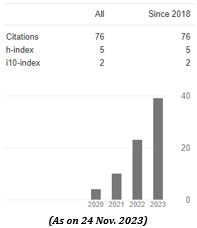Predicting fully-developed channel flow with zero-equation model
Abstract
A new zero-equation model (ZEM) is devised with an eddy-viscosity formulation using a stress length variable which the structural ensemble dynamics (SED) theory predicts. The ZEM is distinguished by obvious physical parameters, quantifying the underlying flow domain with a universal multi-layer structure. The SED theory is also utilized to formulate an anisotropic Bradshaw stress-intensity factor, parameterized with an eddy-to-laminar viscosity ratio. Bradshaw’s structure function is employed to evaluate the kinetic energy of turbulence k and turbulent dissipation rate epsilon . The proposed ZEM is intrinsically plausible, having a dramatic impact on the prediction of wall-bounded turbulence.
Downloads
References
Bradshaw P, Ferriss DH, Atwell NP: Calculation of boundary layer development using the turbulent energy equations. Journal of Fluid Mechanics, 23:3164;1967. DOI: 10.1017/S0022112067002319
Champagne FH, Harris VG, Corrsin S: “Experiments on nearly homogeneous turbulent shear flow.” Journal of Fluid Mechanics, 41:81139; 1970. DOI: 10.1017/S0022112070000538
Durbin PA: Some recent developments in turbulence closure modeling. Annual Review of Fluid Mechanics, 50:77-103; 2018. DOI: 10.1146/annurev-fluid-122316-045020
Kawamura H, Abe H, Matsuo Y: DNS of turbulent heat transfer in channel flow with respect to Reynolds and Prandtl number effect. International Journal of Heat and Fluid Flow, 20(3):196-207;1999. doi:10.1016/S0142-727X (99)00014-4. DOI: 10.1016/S0142-727X(99)00014-4
Menter FR: Two-equation eddy-viscosity turbulence models for engineering applications. AIAA Journal, 32(8):1598-1605; 1994. DOI: https://doi.org/10.2514/3.12149
Mansour NN, Kim J, Moin P: Reynolds-stress and dissipation-rate budgets in a turbulent channel flow. Journal of Fluid Mechanics, 194:15-44;1988. DOI: 10.1017/S0022112088002885
Prandtl L: Bericht uber Untersuchungen zur ausgebildeten Turbu- lenz. Zeitschrift fur angew. Math. u. Mechanik. 5:136-139; 1925. (in German) DOI: 10.1007/978-3-662-11836-8_57
Rahman MM, Keskinen K, Vuorinen V, Larmi M, Siikonen T: Consistently formulated eddy-viscosity coefficient for k-equation model. Journal of Turbulence, 19(11-12):959- 994; 2019. https://doi.org/10.1080/14685248.2019.1567926.
Rahman MM, Miettinen A, Siikonen T: Modified SIMPLE formulation on a collocated grid with an assessment of the simplified QUICK scheme. Numerical Heat Transfer, Part B, 30(3):291-314; 1996. https://doi.org/10.1080/10407799608915084.
Rahman MM, Siikonen T, Miettinen A: A pressure-correction method for solving fluid flow problems on a collocated grid. Numerical Heat Transfer, Part B, 32(1): 63-84; 1997. https://doi.org/10.1080/10407799708914999.
Schlatter P, Orlu R: Assessment of direct numerical simulation data of turbulent boundary layers. Journal of Fluid Mechanics, 659:116126;2010. DOI: 10.1017/S0022112010003113
Segalini A, Orlu R, Alfredsson PH: Uncertainty analysis of the von Karman constant. Experiments in Fluids, 54:1460, 2013. DOI: 10.1007/s00348-013-1460-3
She Z-S, Chen X, Wu Y, Hussain F: New perspective in statistical modeling of wallbounded turbulence. Acta Mechanica Sinica, 26(6):847-861; 2010. DOI: 10.1007/s10409-010-0391-y
She, Z-S, Chen X, Hussain F: Quantifying wall turbulence via a symmetry approach: a Lie group theory. Journal of Fluid Mechanics, 827:322-356; 2017. DOI: 10.1017/jfm.2017.464
She Z-S, Hu N, Wu, Y: Structural ensemble dynamics-based closure model for wall bounded turbulent flow. Acta Mechanica Sinica 25:731-736;2009. DOI: 10.1007/s10409-009-0282-2
Townsend AA: The Structure of Turbulent Shear Flow, 2nd edition,1976. Cambridge University Press.
Wilcox DC: Turbulence Modeling for CFD, vol. 2. La Canada, DCW industries (2006).
Though MIJST follows the open access policy, the journal holds the copyright of each published items.

This work is licensed under a Creative Commons Attribution-NonCommercial 4.0 International License.
















